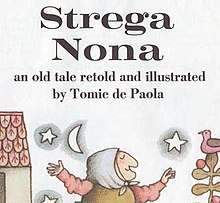Strega Nona
_cover_art.jpg) Cover with correct "an original tale..." subtitle | |
| Author | Tomie dePaola |
|---|---|
| Original title | Strega Nonna |
| Illustrator | Tomie dePaola |
| Country | USA |
| Language | English |
| Genre | Children's |
| Published | 1975 |
| Media type | Print (Hardcover) |
| ISBN | 0-671-66606-1 |
Strega Nona is a children's book written and illustrated by Tomie dePaola. It is Aarne-Thompson type 565, the magic mill. It concerns Strega Nona ("Grandma Witch") and her helper. The helper causes the title character's magic pasta pot to create so much pasta that it nearly flooded and buried a town. The book, which is likely dePaola's best-known work, was published in 1975 and won a Caldecott Honor in 1976.[1][2] It was one of the "Top 100 Picture Books" of all time in a 2012 poll by School Library Journal.[3]
Plot
Set in Calabria, in southern Italy, the book focuses on the exploits of Strega Nona. She is a sort of female witch doctor noted throughout her home village for her numerous successful remedies. She helps her fellow villagers with their troubles, most notably by curing headaches, helping single women find husbands, and ridding people of warts.
Because she was getting old, she employs the assistance of a young man named Big Anthony who pays little attention. He secretly observes her singing a spell to a magic pasta pot to produce large amounts of cooked pasta; unfortunately, he fails to notice that she blows kisses to the pot three times to stop the pasta production. Since Big Anthony cannot stop the pot from cooking, the town is flooded with macaroni noodles.
Saying "the punishment must fit the crime," Strega Nona hands a fork to Big Anthony and commands him to eat all the pasta he has conjured. By nightfall, he is stuffed.
Development

Although the cover and title page of early printings of the book stated that Strega Nona is "an old tale retold and illustrated by Tomie de Paola," in truth dePaola invented the character and the story himself.[4] He wrote the words "Strega Nona" next to a doodle of a woman's head he drew in the early 1970s and later made her the main character in his story based on the Sweet Porridge fairy tale.[5] Later printings of the book bear the accurate subtitle "an original tale written and illustrated by Tomie dePaola."
In the Italian language, the word "strega" means "witch" and the word "nonna" means "grandmother." Just as "grandma" is a colloquial variation of "grandmother," "nona" is a colloquial variation of "nonna." Hence "Strega Nona" means "Grandma Witch."[5] It is clear in the stories, mainly Strega Nona, Her Story, that Nona is the character's actual name.[5]
Other books
Strega Nona and Big Anthony also appear in other books by dePaola, including:
- Big Anthony and the Magic Ring (1979): Introduces Bambolona, "the baker's daughter."
- Strega Nona's Magic Lessons (1982): Big Anthony disguises himself as a girl and takes magic lessons from Strega Nona.
- Merry Christmas, Strega Nona (1986): Strega Nona abandons her usual pursuits in order to prepare a Christmas dinner for the entire town.
- Strega Nona Meets Her Match (1993): Her friend Strega Amelia sets up a modern cure shop which competes with Strega Nona's cure shop.
- Strega Nona: Her Story (1996): Covers Strega Nona's life, telling the readers how she got the magic pasta pot and learned her magic (it all came from the help of her grandmother, Grandma Concetta).
- Big Anthony, His Story (1998): Tells of his life since childhood and how his family noticed that Big Anthony simply does not pay attention.
- Strega Nona Takes a Vacation (2000): Strega Nona sends gifts of candy and bubble baths to Bambolona and Big Anthony.
- Brava, Strega Nona! A Heartwarming Pop-Up Book (2008): Strega Nona gives advice about life.
- Strega Nona's Harvest (2009): Strega Nona teaches Big Anthony about gardening and the importance of order.
- Strega Nona's Gift (2011): Concerns Italian holiday traditions.
- Strega Nona Does It Again (2013): Strega Nona has the perfect remedy for a houseguest who overstays her welcome.
Other media
- Weston Woods Studios produced a 1977 short animated film entitled Strega Nonna based on the book.[6][7]* Thomas Olson and Roberta Carlson adapted Strega Nona, Big Anthony and the Magic Ring, and Strega Nona Her Story as Strega Nona The Musical for the 1986-1987 season of the Children's Theatre Company in Minneapolis.[8] The musical, which went on tour, was also known as "Tomie dePaola’s Strega Nona."[9]
- Strega Nona, Big Anthony, and Bambolona appeared as supporting characters in the 2001 television series Telling Stories with Tomie dePaola with Strega Nona performed by Bill Barretta and Bambolona performed by Julianne Buescher.
See also
References
- ↑ Mehegan, David (2007-12-10). "Tomie dePaola knows his audience". The Boston Globe. Retrieved 2009-04-07.
- ↑ Association for Library Service to Children. "Caldecott Medal & Honor Books, 1938-Present". American Library Association. Retrieved 2013-01-12.
- ↑ Bird, Elizabeth (2012-07-06). "Top 100 Picture Books Poll Results". School Library Journal "A Fuse #8 Production" blog. Retrieved 2013-01-12.
- ↑ MacPherson, Karen (2009-11-17). "Talking with 'Strega Nona' author Tomie dePaola". Pittsburgh Post-Gazette. Retrieved 2013-01-12.
DePaola says people often tell him that their parents or grandparents told them stories about Strega Nona, as if she were part of Italian folklore. In fact, dePaola invented her and said it was the publisher's idea to call it an 'old tale.'
- 1 2 3 dePaola, Tomie. "Notes on Strega Nona by Tomie..." Retrieved 2013-01-12.
- ↑ Strega Nonna on IMDb
- ↑ "Caldecott Literature Series: Strega Nona". New Hampshire Public Television. Archived from the original on 2013-04-15. Retrieved 2013-01-12.
- ↑ "Tomie dePaola's Strega Nona The Musical". 2010-10-29. Retrieved 2013-01-12.
- ↑ Graeber, Laurel (2006-10-13). "Family Fare: A Benevolent Sorcerer and a Bumbling Apprentice". New York Times. Retrieved 2013-01-12.